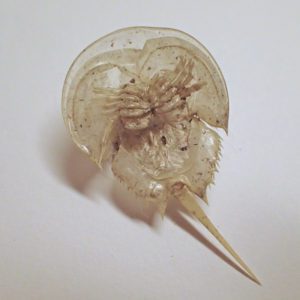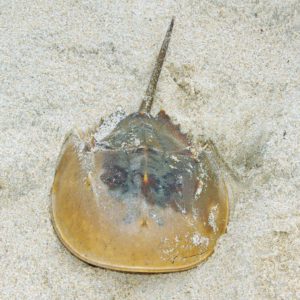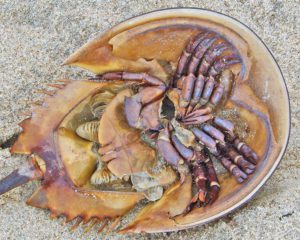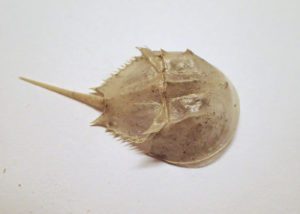Howdy BugFans,
Back in 2011, the BugLady wrote about a spectacular arthropod called the Horseshoe crab that pre-dates insects by maybe 100,000,000 years. Despite the fact that they occur by the millions, horseshoe crabs are facing dire threats to their populations, and the BugLady wondered if anything had changed since the original episode. New text, old text, and pictures of a 1 ½” long, translucent, infant horseshoe crab that washed up on Sanibel long ago, that the BugLady happened to have in her collection. Put your feet up – this takes some telling.
The BugLady had taken herself on a little road trip to the Delaware Bay, the home of the horseshoe crab. Because of their cute faces and their long and primitive lineage (they are called “living fossils”), horseshoe crabs grab our imaginations – they are one of those creatures whose appearance immediately transports us to ancient swamp forests and shallow inland seas.
Horseshoe crabs have, in the words of local news-people, a “Wisconsin Connection.” They are close relatives of our beloved State Fossil called the Trilobite, an ancient inhabitant of those inland seas.
The story of the Atlantic horseshoe crab stretches from the great extinctions of the Silurian Period to the unique threats of the 21st century. The operative question is whether an animal that has survived for almost a half-billion years will join its extinct trilobite ancestor under our watch.
They are shaped like horseshoes, but they’re not crabs. They are under the same big umbrella as crabs – phylum Arthropoda (“jointed limb”) – but horseshoe crabs headed out on a completely different limb of the family tree a very long time ago, and they’re more closely related to spiders and scorpions. They’re in the class Merostomata (“legs attached to the mouth”), in the order Xiphosura (“sword tail”), in the family Limulidae. There are four living horseshoe crab species in the world, three of which reside along the edges of Asia. The Atlantic horseshoe Crab (Limulus polyphemus) (“Limulus” means “askew,” and the BugLady trusts that BugFans recall who Polyphemus was) is found in shallow ocean edges with soft, mucky or sandy floors from Maine through the Gulf of Mexico.
The fact that horseshoe crabs can survive dramatic changes in temperature and salinity and can fast for months (up to a year) helps to explain their longevity, and so does their decidedly tank-like physique. A hard, smooth shell makes them difficult for predators to handle, and the shell is a bulldozer that allows them to dig into the sand/mud for food. From above, they’re divided into three sections – a curved front shell, a trapezoid-shaped middle segment that is hinged to the front shell, and a long, sharp tail that they use as a rudder and as a pry bar when they get flipped over. They can see potential mates from about three feet away with large compound eyes located on the side curve of the front shell, and several centrally located simple eyes register UV light. It’s murky where they hang out, and the tail is equipped with photo-receptors.
Flip one over and your main impression is legs. The first five pairs are for locomotion and for passing food to the mouth, which is, indeed, surrounded by legs. The final pair is adapted for pushing.
Females are larger than males – some females may measure two feet from stem to stern. When it’s time to breed, horseshoe crabs move into shallow waters. There is some suspicion that females are imprinted on the muck they hatched out of, but it’s not known what – or how – they sense there. A female crawls up on shore, attended by piggyback males https://bugguide.net/node/view/352897/bgimage. She lays eggs, a few thousand at a time (up to 120,000 total), in a depression/”nest” in the sand, the males fertilize them externally, and waves cover them https://bugguide.net/node/view/1396827/bgimage.
Eggs hatch in two weeks and the minute’ young (initially tail-less) head for tidal flats to eat and shed and burrow. Their food supply – clams, worms, a few small fish and crabs and other invertebrates – dwell in the mud and sand with them. Rasps on their legs “pre-process” the food, and their sand-filled gizzard finishes the job. They will molt six times, increasing their size by one-third each time, and reaching a half inch by their first birthday. After they blow out the first candle or two, they move to deeper waters, molting once a year and reaching sexual maturity in about ten years. Older horseshoe crabs collect quite a load of hitchhikers during their lives – limpets, sponges, leeches, mussels, crabs, periwinkles, and other snails attach to the shell.
According to Japanese folklore, warriors killed in battle were reborn as horseshoe crabs, eternally roaming the sea floor, celebrated in art and poetry. Eastern tribes of Native Americans harvested horseshoe crabs for food (the muscles in the second section), fertilizer (and they taught the in-coming Europeans this trick), for bowls made from the front part of the shell, and for the sharp tail, used as a tip for fishing spears. The rubbery eggs, roasted “in the shell” are a delicacy in some Asian cuisines, though the roe of one species contains a neurotoxin called TTX by scientists and “Zombie Powder” by practitioners of Vodou.
Horseshoe crabs are armored but not invincible, and they face some unique modern challenges. They are vulnerable to predation by sea turtles, gulls, fish, and crabs (especially as eggs and newly-hatched young), to habitat degradation caused by shoreline development, to pesticide run-off, oil spills, and to being stranded during spawning. Their intersection with humans has not been a happy one – historically horseshoe crabs have been used for human and poultry food and for fertilizer, and today they’re taken and chopped up as bait for conch and eel fishing. Females with eggs are the most desirable bait, and they have even been harvested off their spawning grounds, and it doesn’t take a Brain Trust to see where that road leads.
Alas for the horseshoe crab, researchers discovered in the 1960’s that components of its blood could be used to screen drugs and intravenous compounds/devices for the presence of certain bacterial contaminants. In order to harvest this blood chemical, which is extremely important in today’s medicine, horseshoe crab are caught, relieved of up to one-third of their blood over a period of several days, and then released. In addition, the shell can be used to make absorbable sutures, treat certain eye problems, and speed blood clotting time
When she did her original research six years ago, the BugLady read that the “bleeding” process carried a 3% to 15% mortality rate (a figure offered by the industry). More recent studies suggest that mortality from the process alone could be as high as 30%. Add to that the trauma of being commercially collected and the fact they are stressed by being out of water during the bleeding process (and losing one-third of their blood), and it’s not surprising that they are disoriented and debilitated when they are released, and that females’ ability to spawn may be compromised (In response to criticism, an industry spokesperson noted that, “One of my suppliers built a water slide to put the crabs back into the water. They love it!”). Medical use is expected to go up, not down, but there has been talk of farming horseshoe crabs.
The food web to which Atlantic horseshoe crabs belong is complex and their contribution is vital. In uncountable numbers, horseshoe crab eggs have fueled migrating shorebirds, especially Red Knots, which time their spring migration from South American wintering grounds to coincide with the horseshoe crab spawning season (excellent video at https://www.youtube.com/watch?v=xLy6G53VOPw, and so is the longer one following it) (nice slide show, but cookies http://www.arkive.org/red-knot/calidris-canutus/image-G11960.html). They arrive at Atlantic shore staging areas – irreplaceable way-stations in their 9,000 mile journey – with depleted energy reserves. After two or three weeks of gorging on horseshoe crab eggs, rich in calories, protein and fat (they graze from nests uncovered by wind and waves, leaving plenty of intact nests undiscovered), up to a million shorebirds continue their journey to the Arctic circle having doubled or tripled their body weight. In recent years, as horseshoe crab numbers have fallen, so have shorebird populations. And when an animal doesn’t reproduce until it’s ten, like the horseshoe crab, it takes at least a decade to recover.
Today, population trends for the horseshoe crab are a good-news-bad-news story. They are declining in the Northeast and around much of Florida’s coast, but growing along Southeast beaches. Several Mid-Atlantic States have imposed moratoriums on harvesting horseshoe crabs, and populations there are stabilizing. In the Delaware Bay, the proposed take for the last three years has been 500,000 males and zero females. Biomedical companies harvested around 225,000 annually in the ‘90’s, and that number doubled by 2012 https://www.popularmechanics.com/science/health/a26038/the-blood-of-the-crab/. The problem is that because they return the horseshoe crabs to the water, the biomedical companies are not subject to these restrictions, and they are not required to reveal the numbers of animals they process to anyone except the state DNRs (which share it with the Atlantic States Marine Fisheries Commission).
According to an article called “Medical Labs May be Killing Horseshoe Crabs” that appeared in Scientific American in 2016, “The Atlantic States Marine Fisheries Commission’s most recent survey shows that although the number of horseshoe crabs in the Delaware Bay region has stabilized, the female population is just a third of what the bay is capable of supporting, says Larry Niles, a biologist for several nonprofit conservation groups. And the populations along the coasts of New York State and New England continue to decline. ‘Nobody has ever argued that the crab was going extinct. What we’re talking about is the collapse of an ecosystem, because a key species has been reduced extensively,’ Niles says.”
Long story short, the horseshoe crab is considered to be at a higher level of danger than it was in 1996, and populations could drop by 30% over the next four decades. The BugLady is reminded of the Passenger Pigeon, which also occurred in uncountable numbers, and when over-hunting took its toll and the birds disappeared, it was suggested that they must have flown off somewhere, like South America. Or the moon.
Another change – when this episode was originally posted, it was number 200 in the series. Now, we’re sneaking up on 500!
Kate Redmond, The BugLady
Bug of the Week archives:
http://uwm.edu/field-station/




